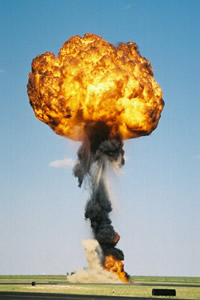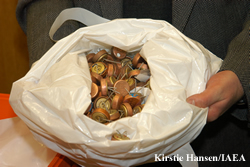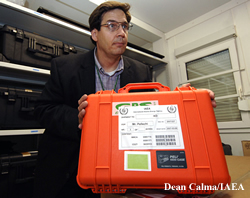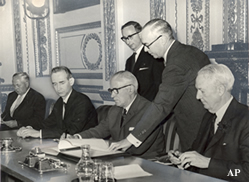Centrifuges and Nuclear Weapon Proliferation

Natural uranium is composed of two isotopes – atoms with slightly different weights that are essentially identical chemically but that can have very different nuclear properties. The bulk of natural uranium is uranium-238 (U-238), but it is the uranium-235 (U-235) isotope (composing less than one percent of natural uranium) that is the fissile material that powers nuclear reactors and nuclear bombs. To be useful, U-235 must be enriched (or increased in concentration) to 3 to 5 percent for a reactor and to about 90 percent for a bomb.
Early in the nuclear age, uranium was enriched by the gaseous diffusion method. Gaseous diffusion is inherently inefficient; the enrichment achieved in a single step of the process is very small so the material must be passed through thousands of steps. As a result, gas diffusion plants are enormous and expensive to build. After each step of the process, the uranium hexafluoride (the gaseous uranium compound used as feed for the diffusion plant) must be recompressed, which makes gas diffusion plants prodigious consumers of electric power. It is no coincidence that the first gas diffusion plant built during the World War II Manhattan Project was located in the middle of the vast Tennessee Valley Authority hydroelectric project – it was the only place in the U.S. that could provide enough electric power. Because of the difficulty and cost of building and operating gas diffusion plants, only wealthy technologically advanced countries were able to enrich uranium, whether for nuclear reactors or nuclear weapons. Industrial scale gaseous diffusion plants were operated in all declared nuclear weapons states .
High-speed gas centrifuges are changing this picture. Gas centrifuges date back to before World War II, but a range of technical problems stopped their industrial application. However, steady technical advances have gradually improved the performance and reduced the cost of centrifuges. High-strength materials and precision machine tools have become more widespread, allowing ever more nations to produce centrifuge parts. Today, centrifuges are the method of choice for uranium enrichment, although some gas diffusion plants are still in operation. In 2007, 72 percent of all enrichment was done by centrifuge plants and only 28 by gaseous diffusion. By 2017 centrifuges are projected to account for 96 percent of all uranium enrichment activity .
Current centrifuge facilities have been built ostensibly to enrich uranium for nuclear reactors. Centrifuges present a proliferation danger because precisely the same machines that produce low enriched uranium fuel for a nuclear reactor can produce highly enriched uranium suitable for nuclear weapons. Even a modest centrifuge plant, one sized to fuel a single nuclear power plant, can produce enough HEU for about twenty bombs in a year. The difference between a military and a civilian enrichment plant is just how the machines are piped together in cascades. This means that a fuel plant could quickly be converted into a weapon plant. Moreover, if the starting material for a bomb program were not natural uranium, but fuel-grade uranium that has been stockpiled, then the time to further enrich the uranium to bomb-grade would be reduced by more than 65 percent. Details of these calculations are provided in the section on Separation Theory.
 Centrifuges also make clandestine enrichment for weapons harder to detect and verify. Because of their size and huge power consumption, gas diffusion plants are difficult to keep hidden from, for example, overhead satellite photography. A centrifuge enrichment plant is more compact and might use as little as one tenth of the power of a diffusion plant. There may be some hope of detecting leaking uranium hexafluoride gas accidently released from a gas centrifuge plant but, in general, a clandestine plant would have no characteristics that would distinguish it easily from any large light industry facility. A centrifuge plant could also more easily be hidden underground or hardened against attack. For example, satellite photographs suggest that the Iranian plant at Natanz is covered by thick concrete and a deep layer of earth [2].
Centrifuges also make clandestine enrichment for weapons harder to detect and verify. Because of their size and huge power consumption, gas diffusion plants are difficult to keep hidden from, for example, overhead satellite photography. A centrifuge enrichment plant is more compact and might use as little as one tenth of the power of a diffusion plant. There may be some hope of detecting leaking uranium hexafluoride gas accidently released from a gas centrifuge plant but, in general, a clandestine plant would have no characteristics that would distinguish it easily from any large light industry facility. A centrifuge plant could also more easily be hidden underground or hardened against attack. For example, satellite photographs suggest that the Iranian plant at Natanz is covered by thick concrete and a deep layer of earth [2].While designing and building centrifuges has become easier, it is still not yet easy. A nation could secretly develop centrifuge capability by importing key components and assembling centrifuges domestically. Manufacture requires access to materials, parts and precision machine tools that are not universally available and are unusual enough that monitoring their trade internationally is feasible. Therefore, it is possible to limit the proliferation and diversion of sensitive technology and curb the development of this potentially dangerous technical capability. To this objective, the International Atomic Energy Agency (IAEA) has defined an export “trigger list”, which is a comprehensive directory of suspect imports [1]. Below are listed a few key items that could be controlled to thwart development of a centrifuge program.

Other key components of centrifuges are the high-speed motors and the variable-frequency power supplies that drive them. The power supplies have limited industrial applications and allow some opportunity for monitoring and control. Ancillary and test equipment is also important, including vibrational test systems, machine tools, multi-plane balancing instruments, mass spectrometers, vacuum pumps, and certain chemicals.
 Like diffusion plants, centrifuges use a gaseous form of uranium, uranium hexafluoride or UF6. The UF6 is produced by chemical conversion of yellow cake (predominantly U308) obtained by milling uranium ore. Uranium exports are monitored by the IAEA; transfer of both source material (natural or depleted uranium) and special fissionable material (Pu-239, U-233 or uranium enriched in U-235 or U-233) above a certain quantity should be reported. Although countries are obliged to report transfer of uranium abroad, domestic uranium mining and milling does not fall under IAEA safeguards. The Safeguards Agreement supplemental to the Nonproliferation Treaty prescribes physical IAEA monitoring of both source and fissionable material in all peaceful nuclear activities inside a country, except for mining and milling, which means that verifications start at the conversion plants. Unlike gas centrifuge components, the equipment and feed chemicals needed for producing UF6 are rather difficult to monitor since many of the key items are common to the chemical industry as a whole. Even though equipment has to be especially ordered, ordinary components can be assembled to into a system designed especially for uranium conversion.
Like diffusion plants, centrifuges use a gaseous form of uranium, uranium hexafluoride or UF6. The UF6 is produced by chemical conversion of yellow cake (predominantly U308) obtained by milling uranium ore. Uranium exports are monitored by the IAEA; transfer of both source material (natural or depleted uranium) and special fissionable material (Pu-239, U-233 or uranium enriched in U-235 or U-233) above a certain quantity should be reported. Although countries are obliged to report transfer of uranium abroad, domestic uranium mining and milling does not fall under IAEA safeguards. The Safeguards Agreement supplemental to the Nonproliferation Treaty prescribes physical IAEA monitoring of both source and fissionable material in all peaceful nuclear activities inside a country, except for mining and milling, which means that verifications start at the conversion plants. Unlike gas centrifuge components, the equipment and feed chemicals needed for producing UF6 are rather difficult to monitor since many of the key items are common to the chemical industry as a whole. Even though equipment has to be especially ordered, ordinary components can be assembled to into a system designed especially for uranium conversion.Centrifuge plants do not have to be clandestine to be a proliferation concern. Because only minor changes are required to convert a civilian enrichment plant into a nuclear weapons material plant, every fuel production centrifuge plant is a potential source of nuclear weapons material. Iran, for example, claims that its centrifuge program at Natantz is entirely for peaceful purposes, specifically to provide fuel for a nuclear reactor. While the international community is not entirely confident of Iran’s claim, and IAEA inspections confirm that currently Iran is not producing highly-enriched uranium but the same centrifuges could be reconfigured to for weapons production.
The potential dual function of all centrifuge plants calls for continuous international inspection to insure that ostensibly commercial plants are not used to produce nuclear weapon material. While technical advances are making centrifuge manufacture and operation ever easier, it is still possible to control key technologies and slow the diffusion of enrichment capability.
The potential dual function of all centrifuge plants calls for continuous international inspection to insure that ostensibly commercial plants are not used to produce nuclear weapon material. While technical advances are making centrifuge manufacture and operation ever easier, it is still possible to control key technologies and slow the diffusion of enrichment capability.
References
[1] INFCIRC/254/Rev.8/Part 1a. (2006, March 20). In International Atomic Energy Agency (IAEA). Retrieved March 19, 2009, from http://www.iaea.org/Publications/Documents/Infcircs/2006/infcirc254r8p1.pdf
[2] Natanz - Iran Special Weapons Facilities. (n.d.). In GlobalSecurity.org . Retrieved March 19, 2009, from http://globalsecurity.org/wmd/world/iran/natanz-imagery2.htm

